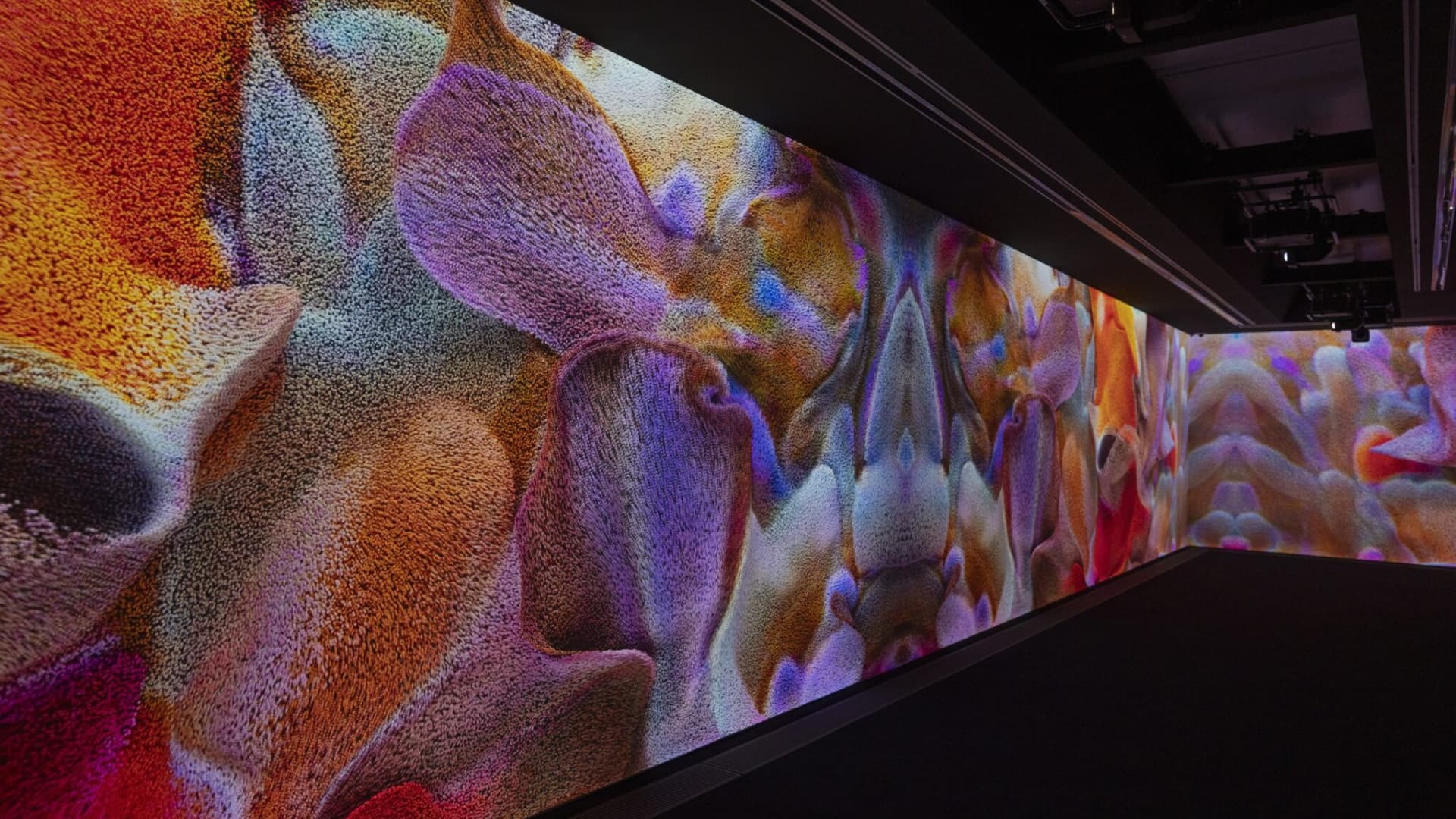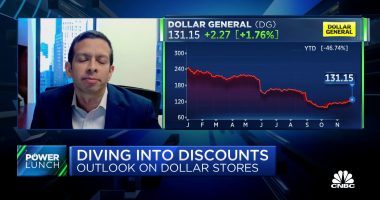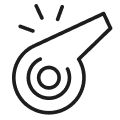
Artist Refik Anadol uses generative AI to produce images, seen here as part of the “Echoes of the Earth: Living Archive” exhibition at Serpentine North, London.
Hugo Glendinning | Courtesy Refik Anadol Studio and Serpentine.
The art world — like many industries — is grappling with how best to use artificial intelligence, especially in its latest form, generative AI.
Image generators like Midjourney and OpenAI’s DALL-E 3 can produce pictures from written prompts, and such technology has been used to create a magazine cover, win an art prize and dress the Pope in a white puffer jacket.
Some artists CNBC spoke to described the technology’s potential as being scary or a threat, or expressed concerns about copyright. But they also said they were excited about what generative AI might bring.
Installation artist Rubem Robierb was “shocked” when he first saw what generative AI could do, he told CNBC by phone. “In its infancy, [generative] AI can create more images in a second [than] the human brain can even process. This is not necessarily a good thing, but we are all here forced into the experiment,” he said in a follow-up email.
Robierb specializes in sculpture, and a piece named “Dandara” was displayed in New York City, in memory of Dandara dos Santos, a transgender woman who was killed in Fortaleza, Brazil, while he also made “Dream Machine,” a large pair of butterfly wings commissioned by Celebrity Cruises for Edge, its billion-dollar cruise ship.
Artist Rubem Robierb with his sculpture “Dream Machine.” Robierb wants “legal boundaries” to be introduced to protect artists’ intellectual property.
Rubem Robierb
The artist, who is based between New York and Miami, said he’s yet to use AI in his work. But he described doing so as “not a matter of choice,” and added that he is considering how and when to use it.
“We can also see it as a threat to creativity. As it exists right now, [generative] AI sources from known images, known artwork, and known artists to complete a task. Legal boundaries must be created in order to protect intellectual property,” Robierb said.
In Europe, the European Commission’s AI Act aims to regulate the technology, depending on how risky it is deemed to be in terms of citizens’ rights or safety, and is likely to come into effect in around two years, according to a December press release.
Generative art
Using generative AI in an ethical manner is a key consideration for London gallery the Serpentine, which has developed AI projects with artists since 2014, according to its CEO Bettina Korek.
One of the gallery’s current exhibitions, Echoes of the Earth: Living Archive, by Refik Anadol, features large-scale AI-generated artworks such as “Artificial Realities: Coral,” which was created using around 135 million images of coral that are “openly accessible online,” according to a press release.
“AI seems very far removed from our kind of human experience. But Refik has created such an immersive and sensorial experience,” Korek told CNBC by video call. “Audiences are really encountering art first, and technology second,” she said, adding that Anadol has focused on the importance of using “ethically sourced” data to train the AI that produces the images.
Artist Refik Anadol used generative AI to create artworks, seen here at the “Echoes of the Earth: Living Archive,” exhibition at the Serpentine North gallery in London, U.K.
Hugo Glendinning | Courtesy Refik Anadol Studio and Serpentine.
Anadol used what he terms a “Large Nature Model,” where data from London’s Natural History Museum and the Smithsonian Institution among others has been used to train an AI to produce content for a work named “Living Archive: Large Nature Model,” which was first shown at the World Economic Forum in Davos, Switzerland in January.
The ethical sourcing of data to train AI is something that’s part of “a much bigger conversation that we’re thinking about with artists,” Korek said, and the Serpentine’s fourth Future Art Ecosystems report, published in March, called for public institutions to “understand themselves as intermediators of the role of AI in society.”
Other galleries, such as 37xDubai in the United Arab Emirates, are embracing AI-generated art. The venue’s exhibition, Generative: Art & Systems, features work by artists including Julian Espagnon, who mixes design, code and art, according to the gallery’s founder and CEO Danilo S. Carlucci.
What are we doing, replacing the human experience?
Shane Guffogg
Artist
Asked whether generative art could match the value of art created by humans, Carlucci said generative art involves creativity and skill, in an email to CNBC. “Some of the artists in our exhibition are highly technical and have a very strong understanding of code. The works they create take hours of labor, and similar to traditional art, the story behind their pieces comes with a thoughtful … message,” he said.
At the Serpentine, the gallery’s Arts Technologies team is working on a number of AI projects, including an exhibition that will explore “dark corridors of what it means to be an artist in the AI age” by artists and musicians Holly Herndon and Mat Dryhurst, which will open in the fall, according to a press release.
Dryhurst and Herndon are also co-founders of Spawning, an organization focusing on data governance for AI. One of its products, search engine Have I Been Trained, lets people see whether their work and images have been used to train some of the large language models that are behind generative AI — with the option to prevent them from being used in future.
AI platforms Stability and Hugging Face are two of the generative platforms using the Have I Been Trained registry, and Spawning is “actively courting” both OpenAI and Midjourney, according to Jordan Meyer, its co-founder and CEO, in an email to CNBC.
AI as an artist’s ‘tool’
Abstract artist Shane Guffogg has mixed feelings about AI. He described AI as “a tool,” in a video call with CNBC. “Part of it is scary. Another part of it is exciting because it enabled me to unlock what I was ‘sensorially’ hearing,” he said.
Guffogg has synesthesia, a sensory condition that means he equates individual colors with particular musical notes, and he wanted to create a music composition based on his art that could be performed by a pianist.
He approached software developers to help him do that for a piece named “Sounds of Color” — part of an exhibition he will show in Venice, Italy, starting April 20 — but found some developers wanted to replace the human element with technology.
“They wanted it to be completely AI-generated based on not even my paintings but based on my movements. And … the human element is removed. And I just said: ‘No, I’m not going to do that’,” Guffogg said.
California-based artist Shane Guffogg worked with an AI software programmer and a pianist to create an exhibition showing in Venice, Italy, between April and November. He said AI technology was both “scary” and “exciting.”
Shane Guffogg
Another developer wanted to make a hologram of Guffogg that could create new art. “He said … once we document all your movements, then it can perpetually generate new paintings of yours long after you’re gone,” Guffogg said. A suggestion he also turned down.
Guffogg worked with AI software programmer Jonah Lynch and pianist Anthony Cardella on “Sounds of Color,” and said he was brought to tears the first time he “heard” one of his paintings being performed. “I could hear all the [musical] influences that I listened to while I was painting,” he said.
Guffogg has not experimented with generative AI programs, but said people have shown him images made that way. Making his own art is about the “joy of discovery,” he said. “What are we doing, replacing the human experience? … Hopefully … it will kind of wear itself down and it won’t be the brave new world any more,” he said of generative AI in the context of art.
Robierb had a similar sentiment. “[An] original artwork only will be original if it’s coming from a person … nothing can beat that, the original creativity. I think at some point, we will walk into an art fair, and we will have to label the artworks [that are] human made,” he told CNBC.
Read More: World News | Entertainment News | Celeb News
CNBC










